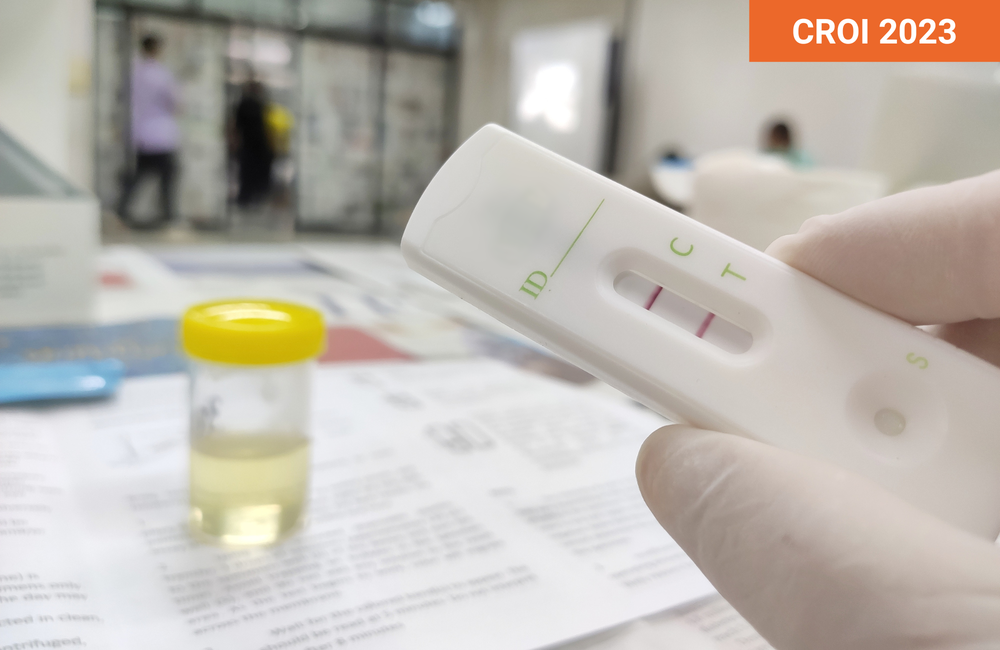
For people taking tenofovir-based HIV treatment, a urine test could be used at the point of care to indicate adherence and predict viral suppression. Research presented last week at the 30th Conference on Retroviruses and Opportunistic Infections (CROI 2023) in Seattle by Dr Kelly Johnson of University of California San Francisco investigated whether the test is good for TAF (tenofovir alafenamide) as well as TDF (tenofovir disoproxil fumarate). This intervention can provide real-time data on adherence, informing counselling, driving adherence interventions and improving the chances of achieving and maintaining viral suppression.
Both TDF and TAF are versions of tenofovir, which are included in almost all triple-drug combination tablets. TDF is the original formulation and TAF is the newer formulation. TDF is also included in the most widely used PrEP pill while TAF is included in Descovy.
Other objective adherence metrics such as drug levels in hair, dried blood spots or plasma are useful in research but fail to provide real-time adherence data in clinical settings. The team previously developed a rapid point-of-care assay to test tenofovir in people who are taking TDF, which successfully indicated adherence. It works similarly to a pregnancy test, providing a real-time yes or no response showing if tenofovir has been taken in the last five days. In comparison to the best available laboratory method of testing urine, it has proven to be highly sensitive and specific. The rapid urine test is likely to be commercially available from Abbott next year.
As TDF and TAF are both used for HIV treatment and prevention, the team wanted to explore whether the test that was originally developed for TDF could also work for people who are taking TAF. It was initially thought that a separate version of the test with a lower cut-off to detect tenofovir would be necessary, due to differences in how the drugs are absorbed and their concentration levels in urine. However, a specific urine assay for TAF does not exist and would require time, funding and resources to develop.
The study
Between June 2019 and December 2021, 83 urine samples were collected from 67 people living with HIV on TAF-based treatment, at two primary care clinics in San Francisco. One of these sites included a clinic that serves patients who are living in unstable housing or experiencing homelessness. All participants were aged 18 and over, the average age was 45 for people with viral suppression and 55 for people without viral suppression. Race and ethnicity data shows samples came from 30 White, 36 Black and 9 Latinx participants, almost all of whom were assigned male at birth.
The urine samples were collected no more than once in each 30-day period and tested with the gold standard laboratory test. Urine levels above and below 1500ng/ml were compared with people's viral loads, as recorded in their medical records.
There were 68 samples from people with viral suppression and 15 from people without viral suppression. There was no significant difference in results from age, sex, gender, or race and ethnicity. The median levels of tenofovir in samples was 3190ng/ml for those virally suppressed at the time of visit and 690ng/ml in samples for those without viral suppression.
Statistical modelling showed that tenofovir levels above 1500ng/ml were strongly associated with viral suppression. The positive predictive value was 91% (in other words, 91% of people with this level of tenofovir were in fact virally suppressed). The negative predictive value was 63% (in other words, 63% of participants with a negative screening test were not virally suppressed).
Conclusion
The study was limited by being done in a real-world setting, which meant that the time of collecting viral load measurements was not standardised. The study was done with people taking TAF as HIV treatment, so it is unknown whether the cut-off of 1500ng/ml would accurately predict HIV seroconversion for people taking TAF as PrEP.
Results suggest that the existing assay could have real-world use, with a positive result suggesting viral suppression in people living with HIV taking TAF. Using the test at point of care might support ongoing adherence monitoring for people living with HIV worldwide who are taking TAF and TDF. One example presented at CROI showed that across 38 clinics in Namibia, combining the urine test with enhanced adherence counselling increased rates of viral suppression to 86% in people who had high viral loads despite previous sessions of enhanced adherence counselling. Its low cost in comparison to viral load and resistance testing could support efforts to achieve 95-95-95 targets.
The team believe that the use of these tests can:
- Be used to identify individuals who need support such as enhanced adherence counselling.
- Clarify if virologic failure is because of adherence or resistance. For example, a test could show that adherence is good, but a patient may not have viral suppression. A resistance test could then show if the cause is resistance.
- Support people to take their medication, which can prevent co-morbidities, stop onward transmission of HIV, protect against resistance and reduce mortality.
A key caveat to any pharmacological measure for adherence is that it should be paired with other interventions to help people improve their adherence.
Johnson KA et al. Urine tenofovir levels predict viral suppression in patients on tenofovir alafenamide. Conference on Retroviruses and Opportunistic Infections, Seattle, abstract 204, 2023.
View the abstract on the conference website.
Johnson KA et al. Urine Tenofovir Levels Strongly Correlate With Virologic Suppression in Patients With Human Immunodeficiency Virus on Tenofovir Alafenamide-based Antiretroviral Therapy. Clinical Infectious Diseases, online ahead of print, 18 October 2022.
Bikinesi L et al. A low-cost, rapid urine test for tenofovir increases ART adherence and viral suppression. Conference on Retroviruses and Opportunistic Infections, Seattle, abstract 1038.5, 2023.
